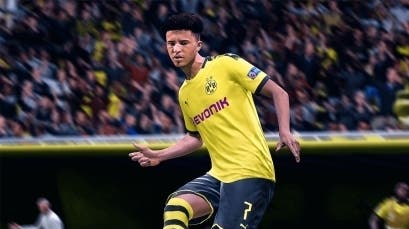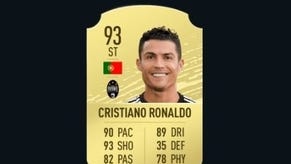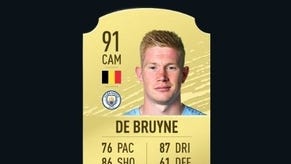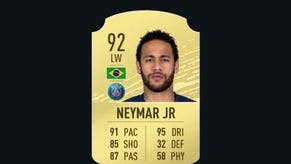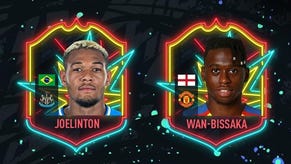With FIFA 20, it feels like EA Sports has finally fixed pace
Don't sweat the Smallings.
EA Sports released the FIFA 20 player ratings yesterday and, unsurprisingly, those top 100 players walked out to all the usual, mega-budget PR fanfare and endless, endless cries of agony from the FIFA subreddit - namely about which player was rated too high (Mustafi?) and which too low (Kaka).
There's one thing that always stands out above all the other ratings chatter, though: pace. Pace is how fast a player is, obviously, but it's come to represent a couple of very specific things since Ultimate Team really came to prominence. First, of course, it is the actual number on the front of a player's card, incorporating an average of their Acceleration and Sprint Speed stats into a single number. This tends to go up and down each year for most players and if it goes up or down too drastically, people don't really like it.
The second thing pace refers to is the problem one: the actual concept itself. Pace, just as a concept overall, is embroiled in an endless back-and-forth in FIFA from one year to the next. One year pace is in, it's meta, and in the simplest terms that means if you pack your team full of very fast, "sweaty" players you will have a better chance of beating a team with better-skilled, slower players. Or at least you will in theory: your fast players will be able to outrun slow players with or without the ball and, FIFA being FIFA (and not a real game of football, where teams can sit deeper and become more compact) that will grant you an undue advantage over the full 12 minutes.
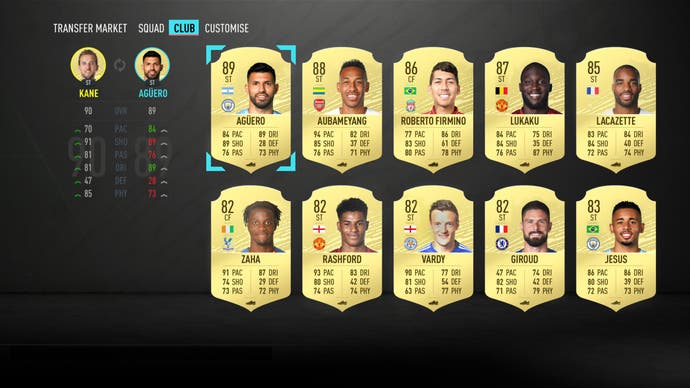
Another year, and pace is out. Fast players like Kylian Mbappé can be through on goal, dribbling with the ball, and be caught up by, I don't know, Chris Smalling. Now Chris Smalling is deceptively fast for a big lad and is a very likeable person, from what I can tell, so I don't want to be cruel - and dribbling does slow you down a bit compared to a flat out sprint, as well - but still, let me tell you: in the real world Chris Smalling is not catching Kylian Mbappé. It's also incredibly unsatisfying to have finally worked a chance to get your very rare and very expensive, thoroughbred racehorse Mbappé through on goal after ten agonising minutes of banging your head against the back four wall, only to have a lumbering defender ghost up behind him, miraculously, and recover the ball. All of a sudden acquiring yourself an Mbappé and building a team and tactic around him tactically doesn't really seem worth it.
Next year, it's back again. On and on forever. Basically, every year EA Sports does a little dance around pace. Maybe some other things play into it, sure. FIFA is fascinating because, as a high-budget sports game, it has an enormous number of interlinked, moving parts, so when you change one thing you have to change lots of others too. When it comes to pace, sometimes it's also Strength - Strength often trumps Pace, when two players are within anything close to grabbling distance, especially in recent FIFAs - or sometimes it's a player's Dribbling, which governs how well they can dribble, obviously. But sometimes, apparently, pace just goes out the window and slow players without the ball are allowed to catch up with fast players with the ball, despite being nowhere near them, because it's the only way EA can avoid quicker players completely breaking the game. FIFA 19, I think it's safe to say, was one of those times.
But in FIFA 20 I think - I think - things might finally be different. I played an earlier build of FIFA 20 back in July, for a good while, and much to my disbelief the pace felt... fine. At that event - the same one with the awkward FUT briefing where EA Sports refused to budge on just about anything - there was also a briefing on the wider gameplay, and pace came up.
In fact, it was the most open EA Sports has been about pace for as long as I can remember. A lot of things came up in that presentation - shooting, tackling, off the ball movement - but all of those felt, for the most part, like the usual back-of-the-box stuff, changed for the sake of change. The section on pace was different.
Sam Rivera, a lead producer on FIFA, gave the presentation. He showed some videos comparing the effects of pace in FIFA 19 versus FIFA 20, in a controlled environment. "We had some feedback that sometimes, slow defenders can catch up easily with fast dribblers, and we're making some changes," he says. No kidding. Cristiano Ronaldo (with the ball) is facing off against Sergio Ramos (without it) in both of these scenarios. In FIFA 19, Ramos always catches up with Ronaldo. In FIFA 20, whether or not Ramos can catch up with Ronaldo depends from one scenario to the next.
All things equal, Ronaldo's Dribbling attribute - not his pace, which is kept the same - is set to four different numbers: 99, 92, 80 and 60. At 99, Ronaldo easily gets past Ramos and gets away. At 92, he gets past but not as far. At 80 and 60, Ramos, despite still being slower, eventually catches up. For the first time, we get to see an actual, dare-I-say-it-scientific look at how pace and other stats tie in together in a game of FIFA. We're shown another comparison.
"The last comparison here which is also very interesting is about knock-on versus Sprint Speed." Player's knocking the ball on - kicking it a bit farther ahead as they sprint - has been reworked a bit for FIFA 20. As Rivera puts it, "there's also user skill that matters here, and knock-on is harder to do because you need to manually request the direction, but, you can get away further." We see the Ramos and Ronaldo scenario again, but this time one where Ronaldo uses a knock-on to push the ball much farther ahead to run onto, and one where he's just sprinting and dribbling. He gets much farther away by knocking it on.
Finally, another comparison involving Kanté and Ronaldo. Kanté is about halfway between Ramos and Ronaldo in terms of pace: "what happens with Kanté here, because he's slightly faster than Ramos, he's able to catch up even when Ronaldo's doing a knock-on, so what this means is that it's not only about pace. If players are similar in terms of attributes - pace attributes - then you can still catch up, so it's not as though the entire game is based on pace again." In other words, just like real life! Imagine.
I tested this out, as best I could, in some friendlies after the presentation. Back then some parts of the game were still apparently in flux - Strength being one of them, according to EA - but the difference is genuinely noticeable. The game has been very intentionally tuned to flow much slower overall, and feel less hectic (which is extremely welcome, in my opinion; a lot of online FIFA matches can feel like 12-minute, jaw-clenched, hyperactivity-induced migraines, the ball moves so fast from one end to the other). When you're in a pace matchup, you feel like you're in a pace matchup, and if you time a knock-on correctly and your player is noticeably faster than the defender, you will get past them. It feels, dare I say it, like football. Time will tell if it bears out in the final build that we'll see in the FIFA 20 demo very soon - Strength can have an almighty difference, for instance, and back in July EA was still taking on feedback from professional players, who might prefer the chaos of 19, for all I know - but it is genuinely promising. For once, I'm excited to give it a run out.
